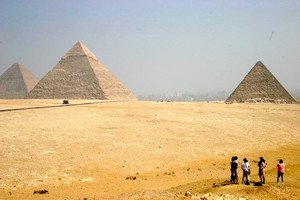
I’m looking through the lens of a camera at one of the Great Pyramids of Giza, trying to fit its vast expanse into a single frame when the fast clip-clop of hooves warns of possible danger. From behind, a camel is being driven towards me at speed. I quickly move forward to let it pass; the beast and its animated rider, who’s been touting for tourist dollars in exchange for photo ops, are being chased by a policeman also atop a camel. Minor drama averted, I return to my “spot” only to find it’s been occupied by half a dozen other camera-toting visitors, who spend the next 10 minutes enjoying essential Kodak moments in front of the only remaining one of Seven Wonders of the Ancient World. Patience is a virtue, however, and after a week of intensive sightseeing at some of the world’s most important ancient archaeological sites, I’ve learned that it pays to take a relaxed outlook on life when things get a bit hectic on the tourist trail.
The Pyramids
Despite the heat, the dust, the chaos caused by the crowds and camels - and the attempts at crowd and camel control - this is one of those experiences which is simultaneously uplifting and humbling. With the Great Pyramid of Giza, also known as the Pyramid of Khufu, on one side and the slightly smaller Pyramid of Khafre on the other, this is the epicentre of ancient Egyptian culture which is defined by these fantastic feats of engineering. The entire Giza pyramid complex, which covers just under one square kilometre, is believed to have been completed by five pharaohs in under one hundred years by around 2650BC. In the past century, intense scientific and historical research still hasn’t revealed exactly how these great structures were built. Many theories, credible and otherwise, have been offered but there is still no definitive answer. The pyramids, and the Great Sphinx, grab all the attention because of their sheer size but closer to the ground there’s also a complex system of causeways, temples, tombs and cemeteries. Most people mistakenly believe that Giza is a remote location, but it sits on a limestone cliff with the bustling city of Cairo as a dramatic backdrop - as if it really needs it. Naturally, the best starting point at Giza is the Great Pyramid which has confounded scientists and engineers with both its size and mathematical precision. It’s been estimated it contains 2.3 million stone blocks with an average weight of one and a half tons each and the four sides of the pyramid are perfectly oriented to the main points of a compass. Each side is 230 metres long and the pyramid is now 136 metres high and viewed up close it seems impossible it could have been built nearly 5,000 years ago. It was built predominately as the tomb for the Pharaoh Khufu.
The Pyramid Of Khafre
Just a few hundred metres away is the Pyramid of Khafre, named after Khufu’s successor, which is often mistakenly identified as the Great Pyramid as it sits on bedrock 10 metres higher giving it the appearance that it’s bigger. The third pyramid in the Giza complex is Menkaure’s which is about half the height of Khafre’s at 62 metres with a base of 103 metres. Walking around the bases of the pyramids is an exercise which takes a lot longer than most people anticipate and gives an appreciation of the scale of the construction. The general consensus among Egyptologists seems to be that the Pyramids were not built by slave labour, as originally thought, but by paid workers who were motivated by their loyalty to the kings. The actual construction is believed to have been carried out with the aid of massive rollers and ropes and levers with a sloping embankment up to the pyramid and estimates of the numbers of workers involved at any one time range from 20,000 to 100,000.
The Great Sphinx
While the mystery of the pyramids has kept scholars busy for many decades, the Great Sphinx also holds its own secrets and is the unofficial national symbol of Egypt. The huge royal sculpture, with the head of a pharaoh (believed to Khafre) and the body of a lion has stirred the imaginations of writers, poets and adventurers - not to mention the millions of tourists that stand in its shadow each year. The Great Sphinx faces east to greet the rising sun and has a temple in front of it. The depiction of a pharaoh’s head on a lion’s body was used to symbolise power and strength with the intelligence of a king - there are other sphinx’s throughout Egypt but this is the one that features as the “face” of the country, both past and present. For most of its life, the Sphinx has actually been buried in sand and even when Napoleon arrived in Egypt in 1798 it was covered up to its neck. For the next century several attempts to dig the Sphinx out were aborted because of the sheer weight of the sand but in 1936, the beast was finally revealed in its full glory, complete with surrounding walls and a moat. Its aura lends weight to the belief that these fantastic monuments of Giza were conceived and built as a result of man’s first realisation of the magical concept of eternity. And as an Arab proverb states: “Man fears Time, yet Time fears the Pyramids.”
- By:
- Ben Hall
Reviews
-
Amazing Place
I travelled here when I was young and before I was married. It had its challenges and I am glad I was with a group of guys, but the memory of the historical sites linger still. I would love to go back one day and take wifey :)
-
Bucket List
I have wanted to visit here for ages but am always worried about safety. It is on my bucket list though and when I can afford an exclusive tour which covers the best bits and offers security I will definitely book to go











